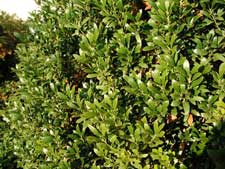Resource Library
Plant of the Week: Inkberry Holly
The University of Arkansas System Division of Agriculture does not promote, support or recommend plants featured in "Plant of the Week." Please consult your local Extension office for plants suitable for your region.
Plant of the Week
Inkberry Holly
Latin: Ilex glabra

Evergreen plants are the backbone of many American gardens. But most of these plants are foreigners; aliens brought in to do the manual labor of defining and outlining the garden. One though, the inkberry holly (Ilex glabra), is native, evergreen and of the right size for garden making, yet it remains relatively uncommon.
Inkberry grows from Nova Scotia to Texas, never venturing far inland from the low-lying coastal plains. In the wild, inkberry holly is often found in bogs, but it grows just fine in typical garden soil.
It's a broad spreading, semi-stoloniferous shrub 6 to 8 feet tall and 8 to 10 feet wide. Branches are mostly upright with non-spiny, richly evergreen 2-inch long leaves. The leaves congregate near the ends of the branches. With age, plants tend to drop their lower leaves and become a bit leggy.
Like all hollies. this species is dioecious with male and female clones. The flowers appear in late spring as new growth appears but are of no ornamental significance. Female plants, if there is a male around for pollination, produce pea-sized black berries that remain on the plant through the winter but are scarcely noticeable. The cultivar Ivory Queen has white berries.
In 1759, Philadelphia nurseryman John Bartram sent inkberry to his correspondent Philip Miller (1691-1771) who was in charge of the Chelsea Physic Garden along the Thames in London.
At this time, this garden had amassed one of the largest collections of plants from throughout the world. Miller is remembered for his Gardener's Dictionary, the first gardening encyclopedia in English that made an attempt to describe the ornamental virtues of garden plants. The plant was known then as Prinos glabra, a name assigned by Linnaeus but changed by Harvard botanist Asa Gray in 1859.
The use of evergreen shrubs in the 18th century was limited. George Washington and Thomas Jefferson used them, but to them the only evergreen that mattered was boxwood. Junipers, arborvitaes and spruce became the evergreens of choice during much of the 19th century. It was not until the early 20th century that now-common evergreens such as azaleas, photinia and a whole host of hollies became commonplace.
So it should not be too surprising that inkberry holly has had a slow start in American gardens. Seed-grown plants were offered for sale by nurseries after World War I but the species remained an infrequent offering. The first improved selection was Compacta, a 5-foot tall shrub selected at Princeton Nursery from seeds collected in the New Jersey Pine Barrens. It was first offered for sale in 1948. Over the next half-century about 20 other cultivars have been selected.
The biggest drawback to inkberry holly in the landscape is its tendency to loose its lower leaves and become open at the base. Not surprisingly most of the clonal selections claim to be more compact and full than the species. Selections such as Shamrock (deep green, 4 feet tall), Nova Scotia (4 feet), Nordic (3 to 4 feet and compact) and Compacta are the most common. Inkberry holly is good for mass planting, foundation planting, informal screening or as an evergreen accent in the border.
Inkberry holly is evergreen from zones 4 to 10 but will survive even into zone 3, but they will suffer winter burn. This species grows best in a fertile, acidic and reasonably moist soil. It's better suited for winter-wet sites than Japanese holly. It grows well in full sun or medium shade, but not extremely dry shade.
Should plants develop leafless bases, don't be afraid to cut them back severely. In fact, this species is a fire-adapted plant that will survive being cut completely back to the ground. Such severe pruning should not be done every year and, if used, should be performed in late winter. Pests are seldom a serious problem.
By: Gerald Klingaman, retired
Extension Horticulturist - Ornamentals
Extension News - February 29, 2008
The University of Arkansas System Division of Agriculture does not maintain lists of retail outlets where these plants can be purchased. Please check your local nursery or other retail outlets to ask about the availability of these plants for your growing area.